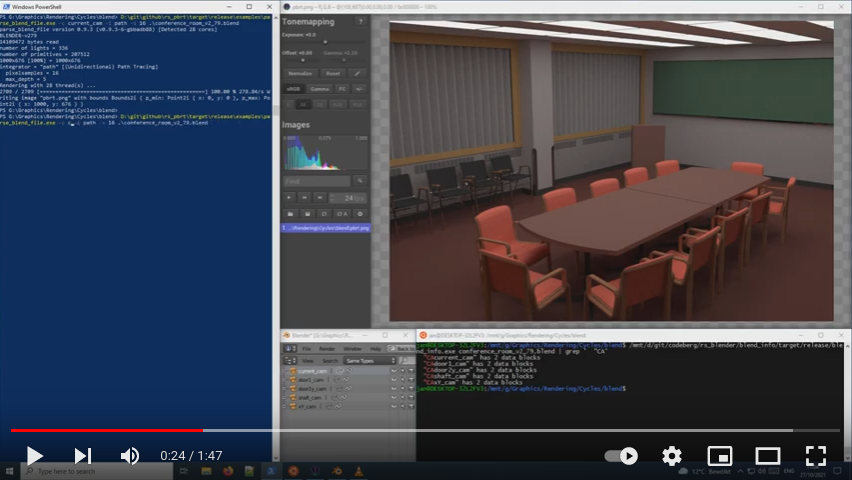In the past I tried several things to get feedback from my readers (of this and related blogs). I opened a forum, I tried to provide very detailed information, etc. From now on I will only create short videos to demonstrate that stuff actually works on my machine, some additional information about what you see, and an email address for you to contact me in case you have questions. You find the email address on the imprint page, but here it is (just in case):
admin [at] janwalter [.] org
Video
Click on the image above to go to the video on YouTube.
Description
What you see in the video above (if you click on the screenshot) was
recorded on Windows 10, basically opening a scene within Blender (by
drag&drop) and making Blender fullscreen. On the upper right you see
the Outliner with the display mode Same Types, which in this case
are five different cameras. By pressing F12 you can render an image
looking through the selected camera. After the first image was
rendered (via Cycles), I did select another camera in the Outliner
and used a shortcut (Ctrl Numpad 0) to look through the selected
camera. I do render an image for all 5 cameras in the scene.
Download conference_room_v2_79.zip and try for yourself:
$ unzip -l conference_room_v2_79.zip
Archive: conference_room_v2_79.zip
Length Date Time Name
--------- ---------- ----- ----
14109472 2021-10-26 17:38 conference_room_v2_79.blend
--------- -------
14109472 1 file
Rendering Research
I provided a lot of scenes in various scene descriptions, so people can download the scenes and render them directly with a renderer of their choice (in case I did have a license for it, and was able to create a scene description for that particular renderer). First I used Blender to create such a scene (a lot of them came from the Radiance renderer) and I wrote my own little addon (for Blender) in Python to export the scene to various (renderer specific) scene description files.
I will continue to provide Blender scenes in the future (mainly
because Blender is open source and my own renderer is able
to render some .blend files directly). The other file format I
will provide is for Houdini (Indie). Some examples are already
online, e.g. a simple Cornell Box, and the Attic
scene by Gleb Alexandrov.
In the future I might be able to use USD directly, e.g. Arnold can render those, but for now I will restrict myself to those renderers which can be used from within Houdini (e.g. via a USD Hydra render delegate) or Blender. Some standalone scene descriptions might be provided from time to time, but I’m planning to make my own renderer more and more production ready and therefore I will take scenes e.g. from the Blender Cloud, change them, so they work directly as input for my own renderer, and provide scenes for Houdini and Blender (version 2.79 for now).
rs-pbrt
So, why bother? There is nothing special about a Blender (2.79) scene being rendered by Cycles (Blender’s internal GI renderer). Well, except that this scene can be rendered directly by rs-pbrt from the command line and your are able to switch the camera from the command line as well:
Click on the image above to go to the video on YouTube.
blog
I will write a little blog post describing the details about the
video and provide a link once it’s published.


